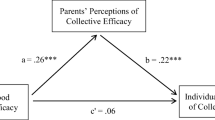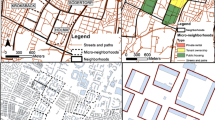Abstract
Different data sources were used to examine hypothesized relations among neighborhood-, family-, and individual-level variables, and perceptions of neighborhood collective efficacy. Data were from 1,105 individuals (56% female, 42% African American, and 58% White) nested within 55 neighborhoods and 392 families, analyzed within a multilevel design using a 3-level model. At the neighborhood level, the study examined relations between Census, police, and neighborhood representative indicators. At the family level, the model examined the influence of marital status and family income. At the individual level, gender and age were examined. Results indicated that age at the individual level, marital status at the family level, and poverty and perceived gang activity at the neighborhood level predicted levels of neighborhood collective efficacy. The study illustrated significant variation across neighborhoods and families, and demonstrates the utility of combining different sources of neighborhood data to examine relations of interest within a multilevel framework.
Similar content being viewed by others
REFERENCES
Bandura, A. (1986). Social foundations of thought and action. Englewood Cliffs, NJ: Prentice-Hall.
Bray, J. H., & Hetherington, E. M. (1993). Families in transition: Introduction and overview. Journal of Family Psychology, 7, 3-8.
Capaldi, D. M., & Patterson, G. R. (1991). Relation of parental transitions to boys' adjustment problems: I. A linear hypothesis. II. Mothers at risk for transitions and unskilled parenting. Developmental Psychology, 27, 489-504.
Coulton, C., Korbin, J., Su, M., & Chow, J. (1995). Community level factors and child maltreatment rates. Child Development, 66, 1262-1276.
Duncan, S. C., Strycker, L. A., Duncan, T. E., He, H., & Stark, M. J. (2002). Telephone recruitment of a random stratified African American and White study sample. Journal of Ethnicity and Substance Abuse, 1, 57-73.
Ensminger, M. E., Lamkin, R. P., & Jacobson, N. (1996). School leaving: A longitudinal perspective including neighborhood effects. Child Development, 67, 2400-2416.
Goldstein, H., & Rasbash, J. (1992). Efficient computational procedures for the estimation of parameters in multilevel models based on iterative generalised least squares. Computational Statistics and Data Analysis, 13, 63-71.
Goldstein, H., Rasbash, J., Plewis, I., Draper, D., Browne, W., Yang, M., et al. (1998). A user's guide to MLwiN. London: Institute of Education.
Gruenewald, P. J., Treno, A. J., Taff, G., & Klitzner, M. (1997). Measuring community indicators: A systems approach to drug and alcohol problems. Thousand Oaks, CA: Sage.
Hirschfield, A., & Bowers, K. J. (1997). The effect of social cohesion on levels of recorded crime in disadvantaged areas. Urban Studies, 34, 1275-1295.
Huber, J. (1990). Presidential address: Macro–Micro links in gender stratification. American Sociological Review, 55, 1-10.
Jones-Webb, R., Snowden, L., Herd, D., Short, B., & Hannan, P. (1997). Alcohol-related problems among black, hispanic and white men: The contribution of neighborhood poverty. Journal of Studies on Alcohol, 58, 539-545.
Kawachi, I., Kennedy, B. P., & Glass, R. (1999). Social capital and self-rated health: A contextual analysis. American Journal of Public Health, 89, 1187-1193.
Pedhazur, E. J. (1997). Multiple regression in behavioral research, (3rd Ed.) New York: Holt, Rinehart & Winst
Ross, C. E., & Jang, S. J. (2000). Neighborhood disorder, fear, and mistrust: The buffering role of social ties with neighbors. American Journal of Community Psychology, 28, 401-420.
Sampson, R. J. (1988). Local friendship ties and community attachment in mass society: A multilevel systemic model. American Sociological Review, 53, 766-779.
Sampson, R. J. (1992). Family management and child development: Insights from social disorganization theory. In J. McCord (Ed.), Facts, frameworks and forecasts: Vol. 3. Advances in criminological theory (pp. 63-93). New Brunswick, NJ: Transaction.
Sampson, R. J. (1998). How do communities undergird or undermine human development? Relevant contexts and social mechanisms. Paper presented at the symposium meeting “Does it take a village? Community effects on children, adolescents, and families,” Pennsylvania State University, November 1998.
Sampson, R. J., & Groves, W. B. (1989). Community structure and crime: Testing social-disorganization theory. American Journal of Sociology, 94, 774-802.
Sampson, R. J., Raudenbush, S., & Earls, F. (1997). Neighborhoods and violent crime: A multilevel study of collective efficacy. Science, 227, 918-924.
Suttles, G. (1968). The social order of the slum. Chicago, IL: University of Chicago Press.
Sweetser, D. A. (1985). Broken homes: Stable risk, changing reasons, changing forms. Journal of Marriage and the Family, 47, 709-715.
Author information
Authors and Affiliations
Corresponding author
Rights and permissions
About this article
Cite this article
Duncan, T.E., Duncan, S.C., Okut, H. et al. A Multilevel Contextual Model of Neighborhood Collective Efficacy. Am J Community Psychol 32, 245–252 (2003). https://doi.org/10.1023/B:AJCP.0000004745.90888.af
Issue Date:
DOI: https://doi.org/10.1023/B:AJCP.0000004745.90888.af




